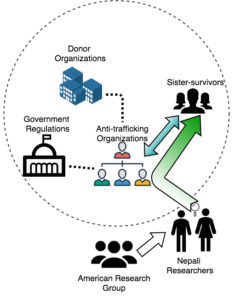 Pervasive gender inequity and discrimination and prevalence of extreme poverty have made young girls and women vulnerable to trafficking in Nepal. The open border between Nepal and India is one of the busiest human trafficking sites in the world with between 5,000 and 12,000 girls trafficked annually. Several factors such as the 2015 earthquake and the on-going political instability have contributed to the problem.
Pervasive gender inequity and discrimination and prevalence of extreme poverty have made young girls and women vulnerable to trafficking in Nepal. The open border between Nepal and India is one of the busiest human trafficking sites in the world with between 5,000 and 12,000 girls trafficked annually. Several factors such as the 2015 earthquake and the on-going political instability have contributed to the problem.
Non-Governmental Organizations (NGOs) implement some measures to prevent trafficking, and rescue and reintegrate survivors. Typically, these organizations offer a protected living situation with some form of counseling and skill-based training. Generally, their ultimate goal is to help the survivors’ reintegrate into society and most preferably with their own families. This can be a problem for many reasons including that many in Nepali society believe that the return of the survivor brings disgrace not just to the individual but to her family and even the entire community.
At the current state, survivors leave the protected living situation to a mostly unknown future. The ultimate outcome wanted by them is to be reintegrated in society with dignity, and a sense of belonging. For greater acceptability in society, they would have to be in situations that allow them to create ties with other members of the community in which they would be treated as equals. To that end, their sense of agency, ownership, and skills in making crafts could be leveraged. However, any design directions would have to ensure that the survivors’ history is not revealed to others.
This research aims to understand the reintegration circumstances of sex-trafficking survivors. One goal is to understand whether and how we could help in the reintegration process. However, we seek to follow a path of mutual discovery and commitment that avoids doing damage, including being open to the idea that the best intervention could be to not intervene.
Related Publications:
- Gautam, A., Tatar, D., & Harrison, S. (2020). Crafting, Communality, and Computing: Building on Existing Strengths To Support a Vulnerable Population. In Proceedings of the 2020 CHI Conference on Human Factors in Computing Systems (CHI’20). [PDF]
- Gautam, A., Tatar, D., & Harrison, S. (2019). Adding Voices to Support Web Navigation Among a Low Digital Literacy Group. In Companion Publication of the 2019 on Designing Interactive Systems Conference 2019 Companion (DIS’19). [PDF]
- Gautam, A., Shrestha, C., Tatar, D., & Harrison, S. (2018). Social Photo-Elicitation: The Use of Communal Production of Meaning to Hear a Vulnerable Population. In Proceedings of the ACM on Human-Computer Interaction, 2 (CSCW’18), 56. [PDF] [CSCW Presentation PDF]
- Gautam, A., Shrestha, C., Kulak, A., Harrison, S., & Tatar, D. (2018, September). Participatory tensions in working with a vulnerable population. In Proceedings of the 15th Participatory Design Conference (PDC’18). ACM. [PDF]
